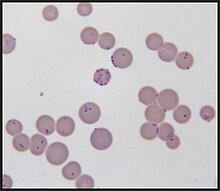| Mycoplasma haemofelis | |
|---|---|

| |
| Scientific classification | |
| Domain: | Bacteria |
| Phylum: | Mycoplasmatota |
| Class: | Mollicutes |
| Order: | Mycoplasmatales |
| Family: | Mycoplasmataceae |
| Genus: | Mycoplasma |
| Species: | M. haemofelis
|
| Binomial name | |
| Mycoplasma haemofelis | |
| Synonyms | |
| |
Mycoplasma haemofelis is a gram-negative epierythrocytic parasitic bacterium. It often appears in bloodsmears as small (0.6 μm) coccoid bodies, sometimes forming short chains of three to eight organisms. It is usually the causative agent of feline infectious anemia (FIA) in the United States.[2]
The ~1.15 Mb genome contains a minimalistic assortment of genes limited to the most basic cellular functions.[3] This leaves M. haemofelis inextricably dependent upon its host for the provision of amino acids, cholesterol, vitamins and fatty acids. The complex and specific conditions that the bacterium requires have made it impossible to culture outside a host thus far.[4]
Arthropod vectors are thought to be the primary source of infection, although M. haemofelis is also known to be transmitted from queen to kitten and following blood transfusion. Immunocompromisation and/or coinfection with FeLV, FIV and other Mycoplasma species can exacerbate symptoms or cause symptoms to arise in previously asymptomatic individuals. Symptoms include anemia, lethargy, fever, and anorexia.[5]
In suspected cases polymerase chain reaction (PCR) tests have become common and commercially available. There is not yet available test that can confirm or deny the presence of infection in the body. Negative PCR doesn't always exclude whenever the cat is infected or not. Furthermore, multiple peripheral blood smears are recommended to perform prior to excluding the disease.[5][6][2][7][8]
Recent evidence suggests that M. haemofelis may be transmissible to humans.[9]
- ^ species/mycoplasma-haemofelis entry in LPSN; Parte, Aidan C.; Sardà Carbasse, Joaquim; Meier-Kolthoff, Jan P.; Reimer, Lorenz C.; Göker, Markus (1 November 2020). "List of Prokaryotic names with Standing in Nomenclature (LPSN) moves to the DSMZ". International Journal of Systematic and Evolutionary Microbiology. 70 (11): 5607–5612. doi:10.1099/ijsem.0.004332.
- ^ a b Messick, Joanne B. (2004). "Hemotrophic mycoplasmas (hemoplasmas): a review and new insights into pathogenic potential". Veterinary Clinical Pathology. 33 (1): 2–13. doi:10.1111/j.1939-165x.2004.tb00342.x. PMID 15048620.
- ^ Razin, S (1992). "Peculiar properties of mycoplasmas: the smallest self-replicating prokaryotes". FEMS Microbiol Lett. 100 (1–3): 423–432. doi:10.1111/j.1574-6968.1992.tb14072.x. PMID 1478475.
- ^ Sykes, Jane E. (1 November 2010). "Feline Hemotropic Mycoplasmas". Vet Clin N Am Small Animal Pract. 40 (6): 1157–1170. doi:10.1016/j.cvsm.2010.07.003. PMID 20933142.
- ^ a b Greene, Craig E., ed. (2006). Infectious diseases of the dog and cat (3rd ed.). St. Louis, Mo.: Saunders Elsevier. ISBN 978-1-4160-3600-5.
- ^ Cite error: The named reference
Willi-et-al-2007was invoked but never defined (see the help page). - ^ Cite error: The named reference
Tasker-2010was invoked but never defined (see the help page). - ^ Sykes, Jane E. (2010). "Feline hemotropic mycoplasmas". Journal of Veterinary Emergency and Critical Care. 20 (1). VECCS, ACVECC, EVECCS (Wiley): 62–69. doi:10.1111/j.1476-4431.2009.00491.x. ISSN 1479-3261. PMID 20230435.
- ^ Santos, AP; Santos RP; Biondo AW; et al. (2009). "Hemoplasma infection in an HIV positive patient, Brazil". Emerg Infect Dis. 14 (12): 1922–1924. doi:10.3201/eid1412.080964. PMC 2634649. PMID 19046522.